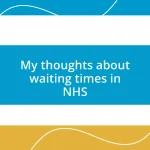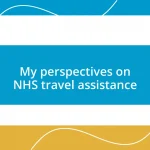Key takeaways:
- NHS is making strides in accessibility with improvements like automatic doors, enhanced online booking systems, and multilingual resources, benefiting patient experience.
- Improved accessibility leads to reduced patient anxiety, better health outcomes, and greater inclusivity, fostering proactive healthcare engagement.
- Involving patients in planning, gathering feedback, and community involvement are essential practices to identify barriers and enhance NHS services effectively.

Understanding NHS accessibility issues
Accessibility within the NHS is a multifaceted issue that many might overlook until it directly affects them. I’ve seen friends struggle to navigate the system, feeling overwhelmed by the complexities of booking appointments or reaching healthcare facilities. It made me wonder, how many more people are silently facing barriers that could easily be addressed?
One aspect that often gets less attention is the physical accessibility of hospitals and clinics. Walking into a building is such a basic expectation, yet I’ve heard from individuals who have encountered staircases that aren’t accompanied by ramps or accessible elevators. It raises the question: why are we still debating the importance of accessible infrastructure in healthcare settings?
Another significant concern is access to information. I’ve observed that vital health resources are often not available in formats that accommodate different needs, like easy-read materials or audio versions. Does this contribute to the feeling of alienation many patients experience? For someone already navigating health challenges, such hurdles can be incredibly disheartening. In my experience, providing clear, accessible communication can make a world of difference in how individuals feel supported and informed.

Current NHS accessibility improvements
As I’ve observed, the NHS has been making strides in improving accessibility across numerous fronts. For example, many hospitals are now emphasizing the installation of automatic doors and improved signage, creating a more welcoming environment. This is not just about convenience; it’s about empowerment. I recently visited a local clinic where I noticed these enhancements made it so much easier for patients like my elderly neighbor, who often felt anxious about physically navigating healthcare spaces.
Here are some key current improvements within the NHS focusing on accessibility:
- Enhanced Online Booking Systems: Many practices are shifting to a user-friendly online appointment system that accommodates various disabilities, making it easier to book visits.
- Training for Staff: There’s an increasing focus on training healthcare staff in understanding different accessibility needs, which makes a tangible difference in patient interactions.
- Improved Transportation Services: Some NHS Trusts are investing in dedicated transportation services that cater specifically to those with mobility challenges, which is a crucial support mechanism.
- Multilingual Resources: Recognizing the multilingual nature of the population, many NHS services are beginning to offer resources in multiple languages, making healthcare more inclusive for non-English speakers.
It’s refreshing to see these efforts being recognized and implemented. Every little change feels like a step toward creating a more inclusive healthcare system where everyone can feel understood and cared for.

Benefits of improved accessibility
Improved accessibility within the NHS offers a myriad of benefits, impacting not just patients, but also healthcare providers. One of the most profound advantages is the reduction of anxiety and stress among patients. For instance, when my grandmother needed treatment, her heightened anxiety about navigating the hospital was palpable. Upon arriving to find ramps, clear signage, and friendly staff, the environment felt so much more manageable. It allowed her to focus on her health rather than the fear of getting lost or discouraged.
Another significant benefit is that improved accessibility translates to better health outcomes. When individuals can access services without barriers, they are more likely to attend appointments and follow up on treatments. I remember when a neighbor of mine with mobility issues finally discovered a clinic that had ample access features. She expressed how it made her feel empowered to take charge of her health rather than feeling like a burden. It’s compelling to witness how such changes can foster a culture of proactive healthcare engagement.
Furthermore, enhanced accessibility fosters inclusivity, allowing a diverse range of patients to receive care. I recently met a non-English speaker who navigated a language barrier alongside physical challenges. With the availability of multilingual resources, he felt welcomed and understood, sharing how it boosted his confidence in seeking care. The ripple effect of enabling diverse populations to engage with health services truly amplifies community well-being.
| Benefit | Impact |
|---|---|
| Reduced Anxiety | Patients feel more at ease and focused on their health journey |
| Better Health Outcomes | Increased likelihood of attending appointments and following treatments |
| Enhanced Inclusivity | Diverse patients can engage with services, improving community well-being |

Challenges still facing NHS
Accessing healthcare shouldn’t feel like negotiating an obstacle course, but for many, it does. I often think of my friend who, due to chronic illness, faces a barrage of challenges every time she tries to visit her GP. The absence of wheelchair ramps at some facilities isn’t merely an inconvenience; it’s a barrier that can deter someone from seeking the help they desperately need. How frustrating is it to think that physical infrastructure could impact one’s health journey so profoundly?
Moreover, while the push towards enhanced online systems is commendable, the digital divide is real. I’ve spoken to several elderly patients who find themselves overwhelmed by the very technology designed to assist them. They often express their feelings of alienation, fearing they’re slipping through the cracks of a system that should be their lifeline. It makes me wonder: how can we ensure that these improvements don’t unintentionally exclude those who are already vulnerable?
Finally, staffing and resource limitations continue to pose significant hurdles. I remember a particularly harrowing experience when my sister needed urgent care but faced long wait times due to a lack of available specialists. The emotional toll of that situation was palpable for everyone involved. The NHS’s commitment to training staff is vital, but how can we balance the need for improved training with the pressing demand for immediate care? These persistent challenges remind us that while progress is being made, there’s still much work to be done to create a truly accessible healthcare system.

Best practices for future enhancements
Implementing best practices for future enhancements in NHS accessibility requires a multifaceted approach that prioritizes patient experience. Personally, I believe that involving patients in the planning process could unearth invaluable insights. For instance, gathering feedback from individuals who navigate the system daily could direct improvements more effectively. Have you ever thought about how genuine conversations with patients could reshape services?
Technology is another area ripe for enhancement, especially in creating user-friendly systems. I recall my frustration when trying to book an appointment online; the interface was confusing and felt like a maze. I often question if we focus too much on digital solutions without considering whether everyone can effectively use them. Simplifying digital access through intuitive design can ensure no one feels alienated.
Furthermore, training staff on disability awareness is crucial. I have seen first-hand how a staff member’s understanding of diverse needs can transform the experience for patients. I once witnessed a nurse go above and beyond for a hearing-impaired individual by using clear visual aids and writing things down. This small act made such a difference in that person’s visit. Shouldn’t every NHS employee be equipped with the knowledge to provide similarly thoughtful care? Investing in comprehensive training could foster a culture of empathy and understanding that ripples through the entire healthcare system.

Importance of patient feedback
Collecting patient feedback is essential for refining the NHS experience. I vividly remember a community meeting where patients shared their stories about accessing care. Listening to their heartfelt accounts highlighted gaps in service and sparked meaningful discussions on necessary changes. Isn’t it fascinating how one voice can echo a chorus of shared challenges?
When patients feel heard, it fosters a sense of trust and belonging. I’ve seen firsthand how a friend’s feedback on wait times led a clinic to adjust its hours. The relief she felt from being considered in that decision was evident; it made her more inclined to engage with her healthcare instead of feeling like an afterthought. Doesn’t it make you wonder how many other simple changes could emerge from listening more closely?
Engaging with patient experiences can illuminate areas for improvement that data alone might miss. I recall a workshop where one participant discussed the mental toll of navigating appointment systems while unwell. This testament not only provided actionable insights but also instilled a sense of urgency in the NHS to adapt. Shouldn’t every healthcare provider prioritize such personal insights to enhance the patient journey?

Community involvement in accessibility planning
Community input in accessibility planning isn’t just a nice-to-have; it’s vital for truly understanding the barriers that people face. I remember volunteering at a local event where individuals shared their struggles with transport to healthcare facilities. Hearing their stories made me realize that these experiences often go unnoticed by planners who may not feel the same impact. Couldn’t we transform accessibility by amplifying these voices?
The diversity of our community brings unique perspectives that can lead to more effective solutions. At another gathering, an elderly woman spoke about her difficulties with stair access in her clinic. It struck me how the smallest adjustments, like installing a ramp, could significantly affect someone’s ability to seek care. Isn’t it remarkable how a single conversation could lead to such essential changes?
Moreover, fostering a collaborative environment where community members are actively involved creates a sense of ownership over local health services. When I attended a focus group aimed at enhancing accessibility, the enthusiasm among participants was palpable. They weren’t just sharing grievances; they were brainstorming solutions together. Don’t you think that when we engage communities directly, we can build systems that truly cater to everyone’s needs?












